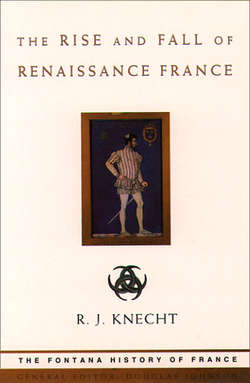Читать книгу The Rise and Fall of Renaissance France - R. Knecht J. - Страница 13
Popular representation
ОглавлениеThe French monarchy after the Hundred Years War was stronger than it had been earlier, when it had had to share power with the great feudal magnates, yet it was not strong enough to ignore the traditional rights and privileges of its subjects. The king’s army rarely reached 25,000 men in peacetime and twice that number in war. Such a force could not be expected to hold down a population of around 15 million, particularly as the king could not depend on the loyalty of his troops; mercenaries were notoriously unreliable. The royal civil service was also minute by modern standards. In 1505 there were only 12,000 officials, or one for each 1250 inhabitants. Consequently, the monarchy could be effective only by enlisting the co-operation of its subjects. This could be done in various ways: by protecting their privileges, by keeping in close contact with them, by controlling a vast system of patronage and by using representative institutions.
At the national level the only representative institution was the Estates-General, made up of elected representatives of the three estates: clergy, nobility and third estate. But the king was under no statutory obligation to call them and in 1484 during the minority of Charles VIII they met for the last time before 1560. It does not follow that the people ceased to have a voice. At the national level, the king often called meetings of one or two estates to discuss particular questions, although such assemblies seem to have been primarily intended for propaganda purposes. As Russell Major has written, they ‘served more to keep alive the idea that the wise king acted only upon the advice of his leading subjects than they did to develop new deliberative techniques’.
However, many French provinces continued to have representative estates of their own during the long period when the Estates-General were in abeyance. They were known as pays d’états and the principal ones were Normandy, Languedoc, Dauphiné, Burgundy, Provence and Brittany. Most of the estates consisted of prelates, nobles with fiefs and representatives of the chief towns, but there were numerous exceptions. In Languedoc, for instance, only the bishops and 22 noblemen were allowed to represent their respective estates. At the opposite end, there were local assemblies where only villages and small towns were represented. The estates depended for their existence on the king: he called them, fixed the date and place of their meeting, appointed their president and determined their agenda. Royal commissioners put forward demands, negotiated with the delegates and met some of their demands. Usually the estates met once a year, but they could meet more often. The estates did not exist simply to vote taxes demanded by the king. Through the petitions they submitted to him, they could have an influence on his policies. They played a major role in legal, legislative and administrative matters. The codification of customs, for example, was done in assemblies of the estates. They had their own permanent staff supported out of special taxes. The estates apportioned and collected royal taxes within their province; they also voted money to build roads and bridges and to support various activities beneficial to the local economy. They raised troops, repaired fortifications, built hospitals and engaged in poor relief.
